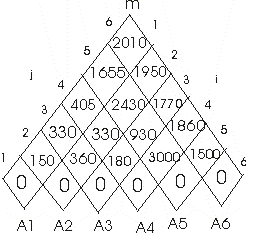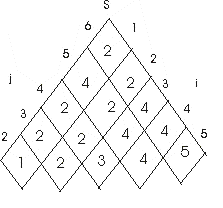This can be done by computing MATRIX – CHAIN – ORDER(P) where
 or
simply using the equation
or
simply using the equation

p0=5, p1=10, p2=3, p3=12, p4=5, p5=50, p6=6
m[1,1] = 0
m[2,2] = 0
m[3,3] = 0
m[4,4] = 0
m[5,5] = 0
m[6,6] = 0


= 150


= 360


= 180


= 3000


= 1500



m[1,3] = 330



m[2,4] = 330



m[3,5] = 930



m[4,6] = 1860



m[1,4] = 405



m[2,5] = 2430



m[3,6] = 1770



m[1,5] = 1655



m[2,6] = 1950



m[1,6] = 2010

Figure 1

Figure 2
Figure 1 & 2 are m & s tables computed by MATRIX-CHAIN-ORDER FOR n=6
For following matrix dimensions:
|
Matrix |
Dimension |
|
A1 |
|
|
A2 |
|
|
A3 |
|
|
A4 |
|
|
A5 |
|
|
A6 |
|
Minimum cost = 2010
The optimal parenthesization: ((A1 * A2) * ((A3 *A4) * (A5 * A6))) which will need 5*50*6+3*12*5+5*10*3+3*5*6+5*3*6 = 1500 + 180 + 150 + 90 + 90 = 2010
Consider that, A is the sequence of matrices. i.e.
A = and s
is the table computed by MATRIX-CHAIN-ORDER, which helps to
multiply the sequence of matrices in an optimal way.
and s
is the table computed by MATRIX-CHAIN-ORDER, which helps to
multiply the sequence of matrices in an optimal way.
The following recursive MATRIX-CHAIN-MULTIPLY
 algorithm performs the optimal matrix-chain multiplication
of
algorithm performs the optimal matrix-chain multiplication
of 
MATRIX-CHAIN-MULTIPLY 
1. if 
2. return 
3. else
//Here LC is a matrix
4. LC = MATRIX-CHAIN-MULTIPLY
// Here, RC is a matrix
5. RC = MATRIX-CHAIN-MULTIPLY
//Result is a matrix that is the result of 
6. Result = MATRIX-MULTIPLY(LC, RC)
7. return Result
The algorithm for MATRIX-MULTIPLY used in the above algorithm of MATRIX-CHAIN MULTIPLY is as follows:
MATRIX – MULTIPLY (A, B)
1. if columns[A] rows[B]
rows[B]
2. then error “incompatible dimensions”
3. else for  to
rows[A]
to
rows[A]
4. for  to
columns[B]
to
columns[B]
5. 
6. for  to
columns[A]
to
columns[A]
7. 
8. return C
The recurrence is given below:

To prove that the solution of the recurrence given in (1) is
 ,
it is enough to prove that
,
it is enough to prove that  .
.
To prove that  , assume
, assume

for all  where
c is the constant.
where
c is the constant.
Substitute different values for n in equation (1) to
calculate the value of  .
.
The equation (1) can be divided as follows:

Calculate the value of  for
different value of n greater than 1.
for
different value of n greater than 1.
Substitute  .
.
The value of k will be  . So
. So
 .
.

Substitute the value of  from
equation (2).
from
equation (2).

Substitute  .
.

Substitute the values of  and
and
 from equation (3) and (4)
from equation (3) and (4)

Similarly calculate the value of  and so
on.
and so
on.
Substitute previous value of  is used to
find the next value of
is used to
find the next value of  .
.
Substitute the value of  in equation
(1)
in equation
(1)

From equation (1)  and
and
 .
So
.
So  .
.
Hence,  .
.
Therefore, the solution of the recurrence given in (1) is
 .
.
Consider the algorithm MATRIX-CHAIN-ORDER,
1. In line 4, the loop can executes n times and line 5
loop can execute  times.
times.
2. In line 8, the loop can executes . m
references two times.
. m
references two times.
3. The total number of times that m is referenced to compute the other entries is


Hence, the total number of references for the entire table






